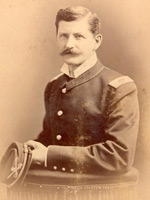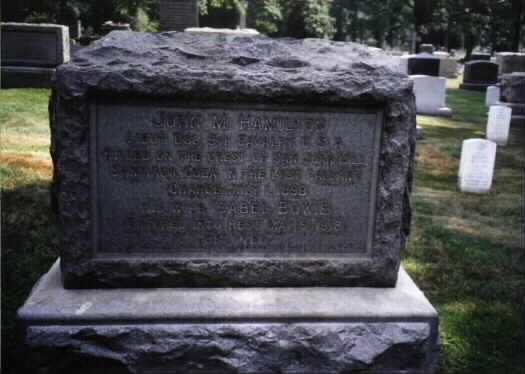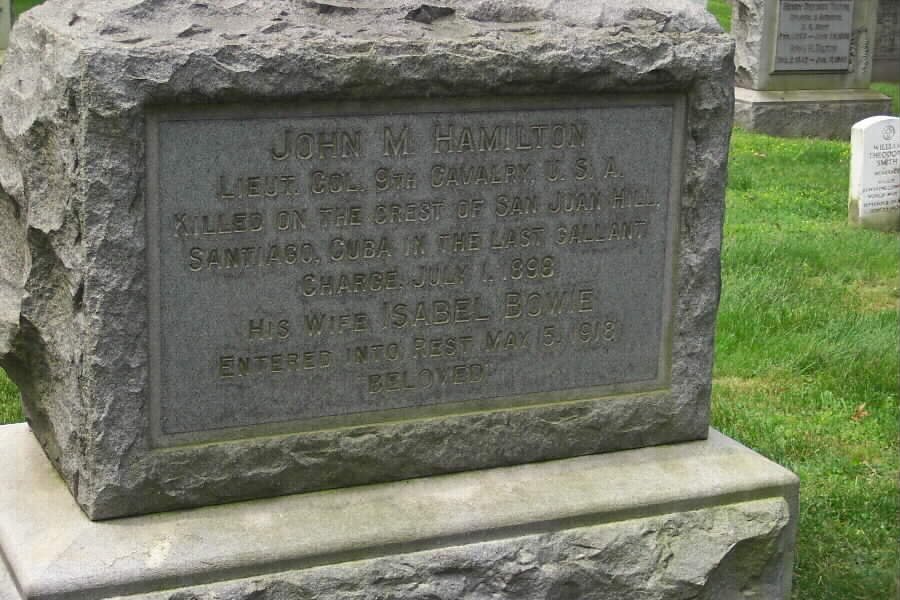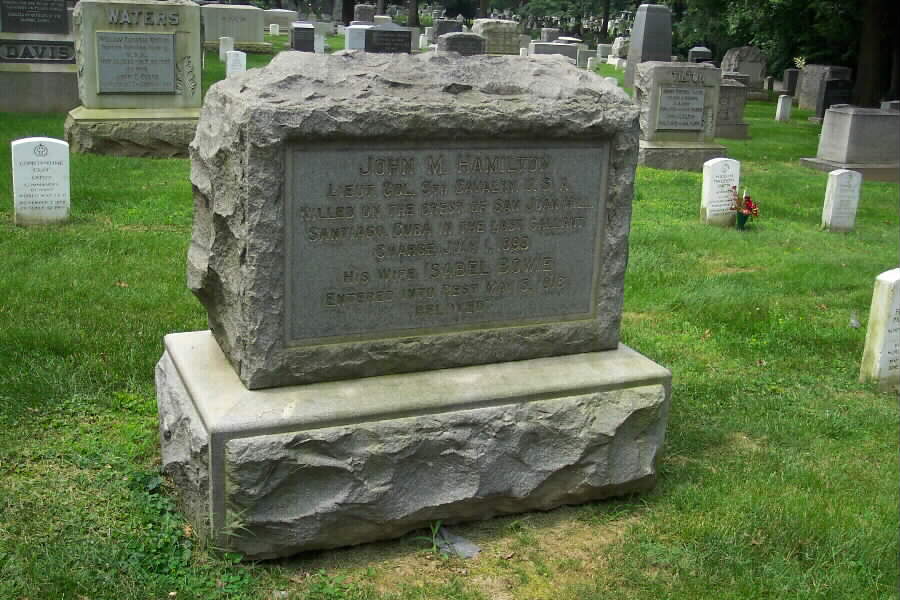Courtesy of the National Cowboy Museum:
John Morrison Hamilton was born in Charleston, Ontario on June 1, 1839. Around 1860, Hamilton moved to Geneva, New York, in the Finger Lakes region, where he had relatives. He intended to go into business. Less than a month after the Civil War began, Hamilton enlisted as a Private in the 33rd New York Volunteer Infantry Regiment. Before his two-year enlistment expired in June 1863, Hamilton saw action in some major battles of the war including First and Second Manassas, Antietam, Fredericksburg, and Chancellorsville, where he suffered a minor injury. Hamilton reenlisted in December 1863 as a second lieutenant of the 9th U. S. Colored Infantry, among the first African American regiments raised during the Civil War. After the war, Hamilton was brevetted a captain of volunteers, later achieving the permanent rank of First Lieutenant.
Hamilton served in the army after the war, first as Captain of the 39th Infantry Regiment stationed in Brownsville, Texas and later doing Reconstruction duty in Louisiana. Captain Hamilton managed a transfer to the 5th U. S. Cavalry Regiment, serving as a recruiting officer in Brooklyn, New York. While in Brooklyn, Hamilton fell in love with Isabel Bowie whom he married on June 28, 1871. For almost three decades “Bella” Hamilton would accompany her husband to military posts all over the West.
In 1872-1874, Captain Hamilton served with the 5th U. S. Cavalry under the command of General George Crook in campaigns to suppress the Tonto Apaches, earning a citation for “conspicuous services and gallantry” for actions in February and March 1873. Much later, he was brevetted a major for bravery for his performance during the Tonto Apache campaign. In 1876, Hamilton was again assigned to Crook’s command, this time for punitive action against Dull Knife’s Cheyenne in the Big Horn Mountains, in the aftermath of the Battle of the Little Big Horn. Later, Hamilton participated in actions against the Bannock Indians in 1878 and the Ute Indians in 1879-1880. Canadian citizen Hamilton finally became a naturalized American citizen in 1882, and he and his family, which now included two daughters, moved to Fort Robinson, Nebraska. Later in the 1880s Hamilton and his family relocated to Fort Riley, Kansas. Hamilton was finally promoted to Major in 1887 and was transferred to the 1st U. S. Cavalry Regiment. While with the 1st Cavalry, he was stationed at Forts Custer and Assinniboine and participated in quelling the Lakota uprising of 1890-1891, the last major engagements of the Indian Wars.
During the first part of the 1890s, he was in garrison, serving as an acting Inspector General in the Departments of the Columbia and the Platte. He returned to the 1st Cavalry at Fort Sill, Indian Territory in 1895, and late the next year was promoted to the rank of Lieutenant Colonel of the 9th U. S. Cavalry at Fort Robinson. While stationed at Fort Robinson, he entertained noted author and artist Frederic Remington. Hamilton figures prominently in Remington’s article, “The Essentials at Fort Adobe,” which appeared in the April 1898 issue of Harper’s New Monthly Magazine.
Shortly after Remington’s article appeared, an impending war with Spain over Cuba, now known as the Spanish-American War, began to dominate the news. The 9th Cavalry made its way first to Chattanooga, Tennessee and later to Tampa, Florida to prepare for a possible invasion of Cuba. With the regimental colonel incapacitated due to illness, command of the regiment fell to Lieutenant Colonel Hamilton. The 9th Cavalry—without their horses—embarked for Cuba aboard the S. S. Miami. Hamilton penned a last short letter to his wife onboard ship, while in sight of Moro Castle at the mouth of Santiago Harbor. On July 1, 1898, the 9th Cavalry, with Hamilton in command, along with elements of the 6th and 10th U. S. Cavalry Regiments and Theodore Roosevelt’s Rough Riders, occupied a skirmish line at the base of San Juan Hill.
Although they had no definite orders, the American troops charged up San Juan Hill, with the nearly 60 year old Hamilton charging with his troops, waving his hat in encouragement. The charge overran the first line of Spanish entrenchments, but while Hamilton continued to direct and encourage his troops, a bullet through the throat cut him down, killing him instantly. Lieutenant Colonel Hamilton was buried later that day almost where he fell with a simple wooden headboard; a bottle was buried with the body to ensure proper identification. Later that month, the Cavalry Division headquarters at El Caney, Cuba, was renamed Camp Hamilton in his honor. In the words of Lieutenant James H. Reeves, who served with him, Hamilton was “a gallant, true, brave soldier.”
In April 1899, the body of Lieutenant Colonel Hamilton was reinterred in Geneva, New York. Sometime after 1903 his body was buried for the last time, with full military honors, in Arlington National Cemetery. Isabel Hamilton died in Oklahoma City in May 1918; she was buried alongside him in Arlington.
John Morrison Hamilton of Canada
Appointed from New York, Private and Corporal Company H 33rd New York Infantry 1 May 1861 to 2 June 1863
Second Lieutenant, 9th United States Colored Infantry, 24 December 1863
First Lieutenant, 15 May 1865
Breveted Captain of United States Volunteers 13 March 1865 for faithful and meritorous service during the Civil War
Honorably mustered out of the Volunteer Service 20 June 1867
Appointed Captain, 39th United States Infantry 6 June 1867
Unassigned 20 Apr 1869
Assigned to the 6th United States Cavalry 30 December 1870
Major, 1st United States Cavalry 21 Apr 1887
Lieutenant Colonel, 9th United States Cavalry 8 December 1896
Breveted Major 27 February 1890 for gallant service in action against Tonto Apache Indians in the foothills of the Tortilla Mountains, Arizonz, 16 January 1873 in connection with gallant conduct in the closing campaign against these Indians
Killed 1 July 1898 at the battle of San Juan Santiago Cuba
Buried with full military honors in Section 1 of Arlington National Cemetery. His wife, Isabel Bowe Hamilton died on 15 May 1918 and was buried with him.
His gravestone states:
“Lieutenant Colonel 9th Cavalry USA
Killed on the crest of San Juan Hill
Santiago, Cuba, in the last gallant
charge, July 1, 1898
HAMILTON, JNO M
LT COL 9 US CAV
DATE OF DEATH: 07/01/1898
BURIED AT: SITE 376
ARLINGTON NATIONAL CEMETERY
HAMILTON, ISABEL W/O JOHN M
DATE OF DEATH: 05/05/1918
DATE OF INTERMENT: Unknown
BURIED AT: SECTION W SITE LOT 376
ARLINGTON NATIONAL CEMETERY
WIFE OF JM HAMILTON – LT COL 9 US CAV
The Spaniards in the next trench line concentrated their small-arms fire on the cavalry. Artillery air bursts added to the American casualties. Colonel John M. Hamilton, commander of the 9th Cavalry, was killed, and Carroll was wounded. The 10th lost the most officers. By that time, Sumner rode up. Upon seeing the infantrymen climbing the other hill, the cavalrymen fired volleys of bullets on the trenches and the blockhouse in support.
Michael Robert Patterson was born in Arlington and is the son of a former officer of the US Army. So it was no wonder that sooner or later his interests drew him to American history and especially to American military history. Many of his articles can be found on renowned portals like the New York Times, Washingtonpost or Wikipedia.
Reviewed by: Michael Howard




